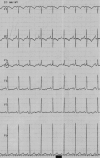Electrocardiographic findings at initial diagnosis in children with isolated left ventricular noncompaction
- PMID: 21496170
- PMCID: PMC6932210
- DOI: 10.1111/j.1542-474X.2011.00428.x
Electrocardiographic findings at initial diagnosis in children with isolated left ventricular noncompaction
Abstract
Background: The aim of this study was to comprehensively evaluate electrocardiographic (ECG) findings of isolated left ventricular noncompaction (IVNC) patients at initial diagnosis and to explore the correlation between them and the clinical, echocardiographic, and magnetic resonance imaging (MRI) findings.
Methods: Twenty-three patients diagnosed with IVNC by echocardiography and cardiac MRI between January 2006 and June 2010 were enrolled in this study. The patients were examined with standard ECG and 24-hour Holter ECG. For comparison purpose, ECGs of 50 healthy children of similar ages and demographic characteristics were taken.
Results: In 87% of patients, ECG abnormalities were found. The most frequently seen ECG findings were left ventricular hypertrophy, ST-segment depression, and negative T wave related to abnormal repolarization particularly in DII, DIII, and V(4-6) leads, as well as prolonged PR and QTc intervals. No ECG features or patterns were found that were specific to the disease. In contrast to adult patients, while no intraventricular conduction defects (particularly in the left bundle brach) were found in any of our patients, 13% had considerable bradycardia and one required a pacemaker. The Holter ECG recordings showed supraventricular tachycardia attacks in two patients and a short ventricular tachycardia attack in one. Patients whose echocardiograms and MRI showed left ventricular systolic dysfunction and left ventricular dilatation had signs of left ventricular hypertrophy and repolarization abnormality on their ECGs, but there was no significant difference in PR, QRS, and QTc intervals.
Conclusion: Regardless of how frequently left ventricular hypertrophy and repolarization abnormalities are found on IVNC patients' initial ECGs, we think that they are not unique to the disease but are related to the severity of the cardiomyopathy.
©2011, Wiley Periodicals, Inc.
Figures




Similar articles
-
Electrocardiographic characteristics at initial diagnosis in patients with isolated left ventricular noncompaction.Am J Cardiol. 2009 Oct 1;104(7):984-9. doi: 10.1016/j.amjcard.2009.05.042. Am J Cardiol. 2009. PMID: 19766768
-
Clinical features of isolated ventricular noncompaction in adults long-term clinical course, echocardiographic properties, and predictors of left ventricular failure.J Card Fail. 2006 Dec;12(9):726-33. doi: 10.1016/j.cardfail.2006.08.002. J Card Fail. 2006. PMID: 17174235
-
Quantitative electrocardiographic measures, neuromuscular disorders, and survival in left ventricular hypertrabeculation/noncompaction.Ann Noninvasive Electrocardiol. 2013 May;18(3):251-5. doi: 10.1111/anec.12053. Ann Noninvasive Electrocardiol. 2013. PMID: 23714083 Free PMC article.
-
Electrocardiographic findings suggestive of cardiomyopathy: what to look for and what to do next.Curr Sports Med Rep. 2013 Mar-Apr;12(2):77-85. doi: 10.1249/JSR.0b013e3182874abb. Curr Sports Med Rep. 2013. PMID: 23478557 Review.
-
[Doubts of the cardiologist regarding an electrocardiogram presenting QRS V1-V2 complexes with positive terminal wave and ST segment elevation. Consensus Conference promoted by the Italian Cardiology Society].G Ital Cardiol (Rome). 2010 Nov;11(11 Suppl 2):3S-22S. G Ital Cardiol (Rome). 2010. PMID: 21361048 Italian.
Cited by
-
Biventricular noncompaction presented with symptomatic complete heart block - Report of a case and review of literature.J Cardiovasc Dis Res. 2013 Jun;4(2):152-5. doi: 10.1016/j.jcdr.2013.03.003. Epub 2013 Jun 18. J Cardiovasc Dis Res. 2013. PMID: 24027376 Free PMC article.
-
Sinus node dysfunction as the first manifestation of left ventricular noncompaction with multiple cardiac abnormalities.Indian Pacing Electrophysiol J. 2013 Aug 1;13(4):157-61. doi: 10.1016/s0972-6292(16)30651-9. eCollection 2013. Indian Pacing Electrophysiol J. 2013. PMID: 24086099 Free PMC article.
-
Noncompaction cardiomyopathy. Is it more than noncompaction?Herz. 2013 Mar;38(2):216-8. doi: 10.1007/s00059-012-3667-0. Epub 2012 Sep 8. Herz. 2013. PMID: 22955687
-
Author`s Reply.Anatol J Cardiol. 2018 Nov;20(5):308. Anatol J Cardiol. 2018. PMID: 30391975 Free PMC article. No abstract available.
-
The Electrocardiogram in the Diagnosis and Management of Patients With Left Ventricular Non-Compaction.Curr Heart Fail Rep. 2022 Dec;19(6):476-490. doi: 10.1007/s11897-022-00580-z. Epub 2022 Oct 13. Curr Heart Fail Rep. 2022. PMID: 36227527 Review.
References
-
- Pignatelli RH, McMahon CJ, Dreyer WJ, et al Clinical characterization of left ventricular noncompaction in children: A relatively common form of cardiomyopathy. Circulation 2003;108:2672–2678. - PubMed
-
- Elshershari H, Okutan V, Celiker A. Isolated noncompaction of ventricular myocardium. Cardiol Young 2001;11:472–475. - PubMed
-
- Tsai SF, Ebenroth ES, Hurwitz RA, et al Is left ventricular noncompaction in children truly an isolated lesion? Pediatr Cardiol 2009;30:597–602. - PubMed
-
- Maron BJ, Towbin JA, Thiene G, et al Contemporary definitions and classification of the cardiomyopathies: An American Heart Association Scientific Statement from the Council on Clinical Cardiology, Heart Failure and Transplantation Committee; Quality of Care and Outcomes Research and Functional Genomics and Translational Biology Interdisciplinary Working Groups; and Council on Epidemiology and Prevention. Circulation 2006;113:1807–1816. - PubMed
-
- Nugent AW, Daubeney PE, Chondros P, et al National Australian Childhood Cardiomyopathy Study. The epidemiology of childhood cardiomyopathy in Australia. N Engl J Med 2003;348:1639–1646. - PubMed
MeSH terms
LinkOut - more resources
Full Text Sources
Medical
Research Materials

